Please help me with a three page reflection paper (I will double space this) on an excerpt from this the provided paperwork. I do not want it to be a summary of what I have said. I want you to decide what you think about the ideas. Agreeing or disagreeing.
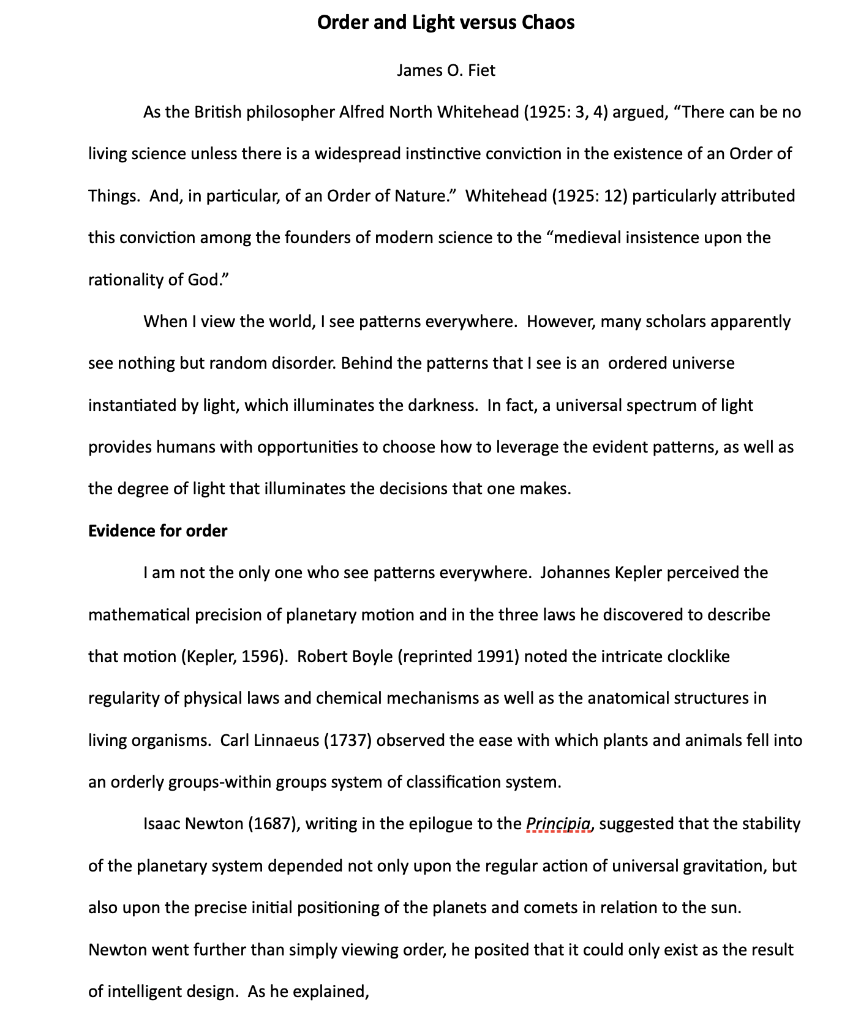
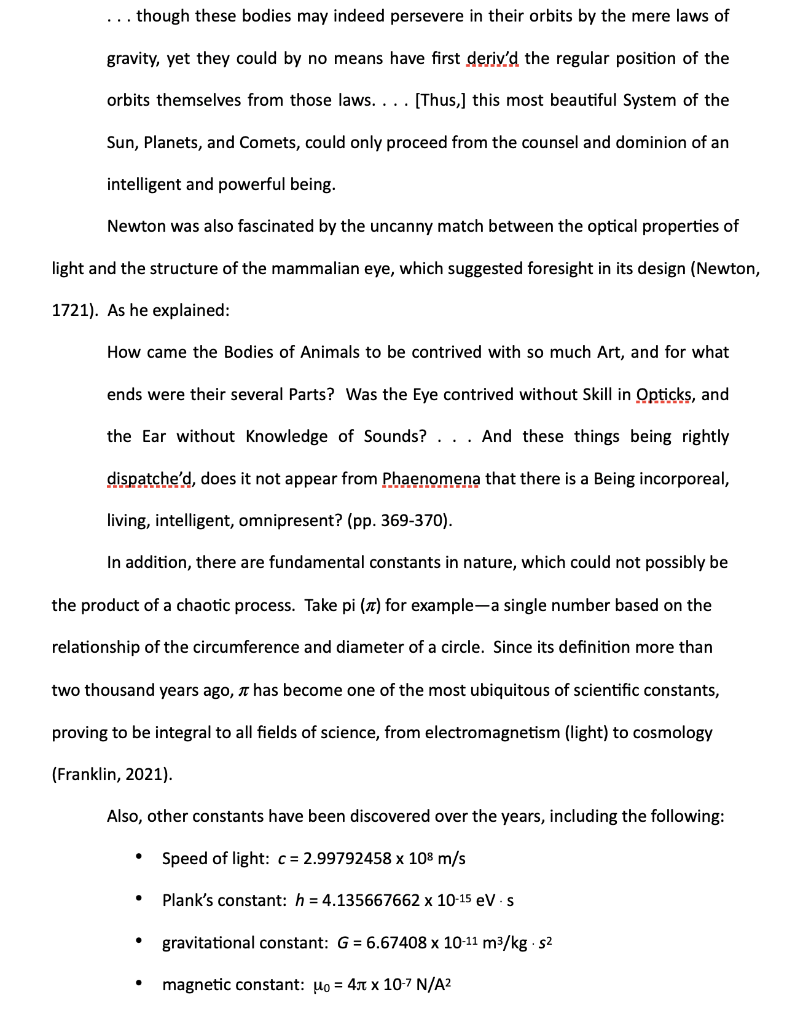
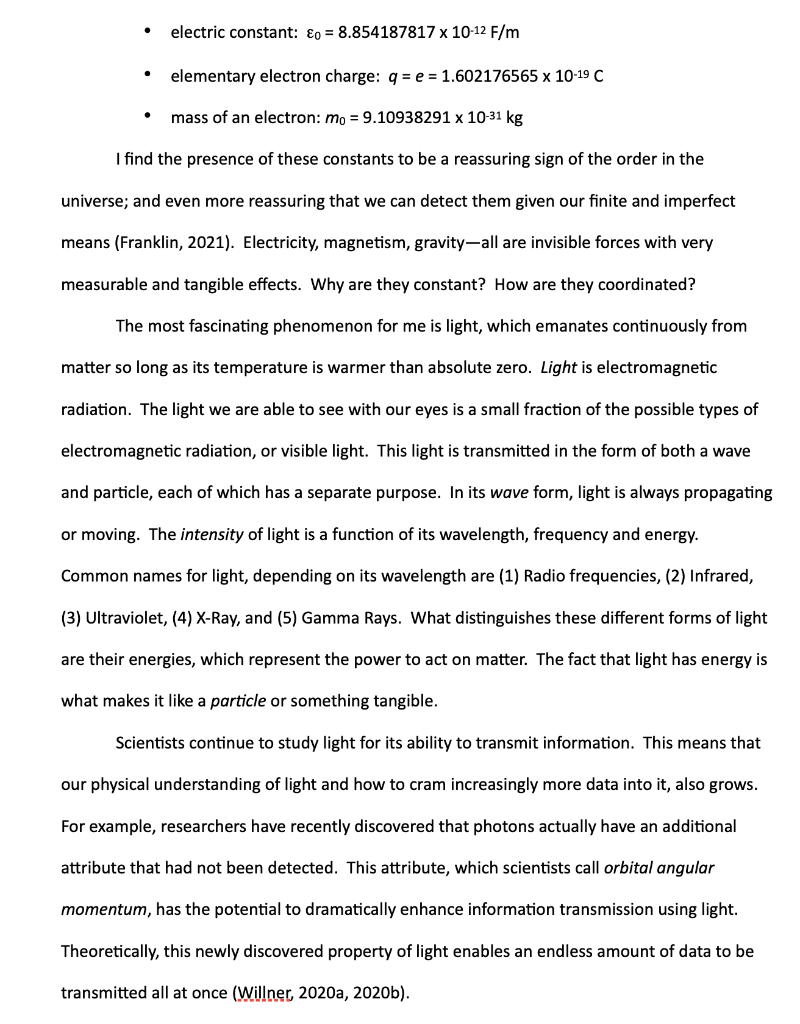
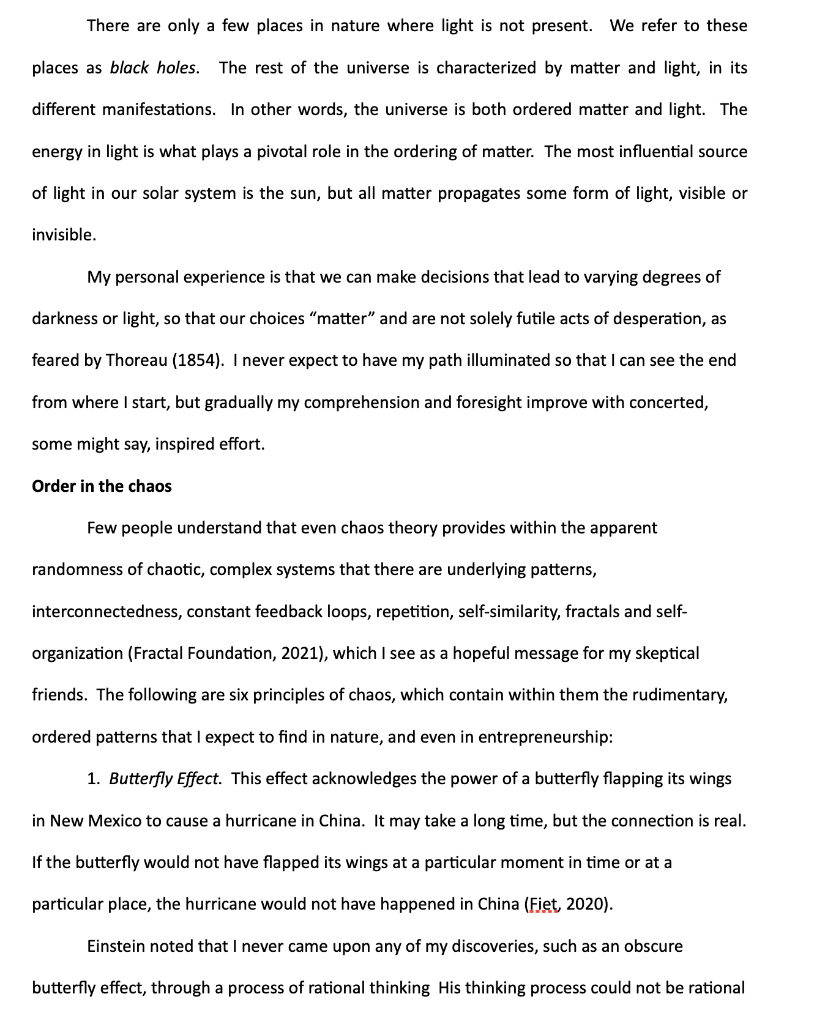
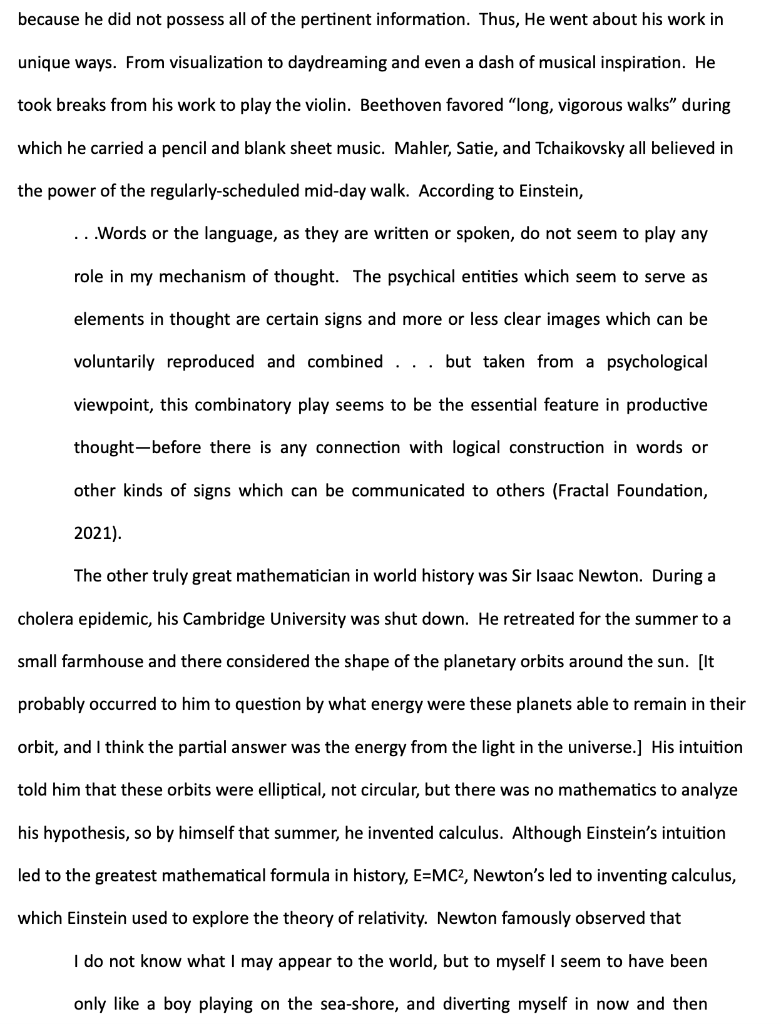


Order and Light versus Chaos James O. Fiet As the British philosopher Alfred North Whitehead (1925:3,4) argued, "There can be no living science unless there is a widespread instinctive conviction in the existence of an Order of Things. And, in particular, of an Order of Nature." Whitehead (1925: 12) particularly attributed this conviction among the founders of modern science to the "medieval insistence upon the rationality of God." When I view the world, I see patterns everywhere. However, many scholars apparently see nothing but random disorder. Behind the patterns that I see is an ordered universe instantiated by light, which illuminates the darkness. In fact, a universal spectrum of light provides humans with opportunities to choose how to leverage the evident patterns, as well as the degree of light that illuminates the decisions that one makes. Evidence for order I am not the only one who see patterns everywhere. Johannes Kepler perceived the mathematical precision of planetary motion and in the three laws he discovered to describe that motion (Kepler, 1596). Robert Boyle (reprinted 1991) noted the intricate clocklike regularity of physical laws and chemical mechanisms as well as the anatomical structures in living organisms. Carl Linnaeus (1737) observed the ease with which plants and animals fell into an orderly groups-within groups system of classification system. Isaac Newton (1687), writing in the epilogue to the Principia, suggested that the stability of the planetary system depended not only upon the regular action of universal gravitation, but also upon the precise initial positioning of the planets and comets in relation to the sun. Newton went further than simply viewing order, he posited that it could only exist as the result of intelligent design. As he explained, ... though these bodies may indeed persevere in their orbits by the mere laws of gravity, yet they could by no means have first deriv'd the regular position of the orbits themselves from those laws. ... [Thus,] this most beautiful System of the Sun, Planets, and Comets, could only proceed from the counsel and dominion of an intelligent and powerful being. Newton was also fascinated by the uncanny match between the optical properties of light and the structure of the mammalian eye, which suggested foresight in its design (Newton, 1721). As he explained: How came the Bodies of Animals to be contrived with so much Art, and for what ends were their several Parts? Was the Eye contrived without Skill in Optickss, and the Ear without Knowledge of Sounds? ... And these things being rightly dispatche'd, does it not appear from Phaenomena that there is a Being incorporeal, living, intelligent, omnipresent? (pp. 369-370). In addition, there are fundamental constants in nature, which could not possibly be the product of a chaotic process. Take pi () for example-a single number based on the relationship of the circumference and diameter of a circle. Since its definition more than two thousand years ago, has become one of the most ubiquitous of scientific constants, proving to be integral to all fields of science, from electromagnetism (light) to cosmology (Franklin, 2021). Also, other constants have been discovered over the years, including the following: - Speed of light: c=2.99792458108m/s - Plank's constant: h=4.1356676621015eVs - gravitational constant: G=6.674081011m3/kgs2 - magnetic constant: 0=4107N/A2 - electric constant: 0=8.8541878171012F/m - elementary electron charge: q=e=1.6021765651019C - mass of an electron: m0=9.109382911031kg I find the presence of these constants to be a reassuring sign of the order in the universe; and even more reassuring that we can detect them given our finite and imperfect means (Franklin, 2021). Electricity, magnetism, gravity-all are invisible forces with very measurable and tangible effects. Why are they constant? How are they coordinated? The most fascinating phenomenon for me is light, which emanates continuously from matter so long as its temperature is warmer than absolute zero. Light is electromagnetic radiation. The light we are able to see with our eyes is a small fraction of the possible types of electromagnetic radiation, or visible light. This light is transmitted in the form of both a wave and particle, each of which has a separate purpose. In its wave form, light is always propagating or moving. The intensity of light is a function of its wavelength, frequency and energy. Common names for light, depending on its wavelength are (1) Radio frequencies, (2) Infrared, (3) Ultraviolet, (4) X-Ray, and (5) Gamma Rays. What distinguishes these different forms of light are their energies, which represent the power to act on matter. The fact that light has energy is what makes it like a particle or something tangible. Scientists continue to study light for its ability to transmit information. This means that our physical understanding of light and how to cram increasingly more data into it, also grows. For example, researchers have recently discovered that photons actually have an additional attribute that had not been detected. This attribute, which scientists call orbital angular momentum, has the potential to dramatically enhance information transmission using light. Theoretically, this newly discovered property of light enables an endless amount of data to be transmitted all at once (Willner, 2020a, 2020b). There are only a few places in nature where light is not present. We refer to these places as black holes. The rest of the universe is characterized by matter and light, in its different manifestations. In other words, the universe is both ordered matter and light. The energy in light is what plays a pivotal role in the ordering of matter. The most influential source of light in our solar system is the sun, but all matter propagates some form of light, visible or invisible. My personal experience is that we can make decisions that lead to varying degrees of darkness or light, so that our choices "matter" and are not solely futile acts of desperation, as feared by Thoreau (1854). I never expect to have my path illuminated so that I can see the end from where I start, but gradually my comprehension and foresight improve with concerted, some might say, inspired effort. Order in the chaos Few people understand that even chaos theory provides within the apparent randomness of chaotic, complex systems that there are underlying patterns, interconnectedness, constant feedback loops, repetition, self-similarity, fractals and selforganization (Fractal Foundation, 2021), which I see as a hopeful message for my skeptical friends. The following are six principles of chaos, which contain within them the rudimentary, ordered patterns that I expect to find in nature, and even in entrepreneurship: 1. Butterfly Effect. This effect acknowledges the power of a butterfly flapping its wings in New Mexico to cause a hurricane in China. It may take a long time, but the connection is real. If the butterfly would not have flapped its wings at a particular moment in time or at a particular place, the hurricane would not have happened in China (Fiet, 2020). Einstein noted that I never came upon any of my discoveries, such as an obscure butterfly effect, through a process of rational thinking His thinking process could not be rational because he did not possess all of the pertinent information. Thus, He went about his work in unique ways. From visualization to daydreaming and even a dash of musical inspiration. He took breaks from his work to play the violin. Beethoven favored "long, vigorous walks" during which he carried a pencil and blank sheet music. Mahler, Satie, and Tchaikovsky all believed in the power of the regularly-scheduled mid-day walk. According to Einstein, ...Words or the language, as they are written or spoken, do not seem to play any role in my mechanism of thought. The psychical entities which seem to serve as elements in thought are certain signs and more or less clear images which can be voluntarily reproduced and combined ... but taken from a psychological viewpoint, this combinatory play seems to be the essential feature in productive thought-before there is any connection with logical construction in words or other kinds of signs which can be communicated to others (Fractal Foundation, 2021). The other truly great mathematician in world history was Sir Isaac Newton. During a cholera epidemic, his Cambridge University was shut down. He retreated for the summer to a small farmhouse and there considered the shape of the planetary orbits around the sun. [It probably occurred to him to question by what energy were these planets able to remain in their orbit, and I think the partial answer was the energy from the light in the universe.] His intuition told him that these orbits were elliptical, not circular, but there was no mathematics to analyze his hypothesis, so by himself that summer, he invented calculus. Although Einstein's intuition led to the greatest mathematical formula in history, E=MC2, Newton's led to inventing calculus, which Einstein used to explore the theory of relativity. Newton famously observed that I do not know what I may appear to the world, but to myself I seem to have been only like a boy playing on the sea-shore, and diverting myself in now and then finding a smoother pebble or a prettier shell than ordinary, whilst the great ocean of truth lay all undiscovered before me. It is noteworthy that Newton's pebbles and shells existed objectively. Although he like Einstein was unsure about how to approach finding them, nevertheless they existed and probably still exist today. In total sympathy with Newton, Einstein humbly proclaimed, "If we knew what we were doing, we would not call it research," which I believe should be the motto for all doctoral students, and dare I say, tenured full professors. It does not suggest that truth does not exist, nor that we cannot find it. 2. Unpredictability-the next principle of chaos. Because we can never know all of the initial conditions of a complex system, we cannot hope to predict its ultimate fate. Even slight measurement errors could be dramatically amplified. 3. Order/Disorder. Chaos is not simply disorder. Chaos explores the transitions between order and disorder, which often occur in surprising ways. 4. Mixing. Turbulence ensures that two adjacent points in a complex system will eventually end up in very different positions. One can imagine two adjacent molecules in the Pacific Ocean, one ending up near Japan and the other on a California beach. This occurs because turbulence occurs at every level of aggregation and is non-linear. 5. Feedback: In the presence of feedback, systems can become more chaotic, such as when there is a rush to trade on a stock market-the trading itself generates a self-reinforcing, accelerated pattern of trading. 6. Fractals. A fractal is a never ending pattern. They are infinitely complex patterns that are self-similar across different scales. They are created by repeating a simple pattern in an unending feedback loop. Driven by recursion, fractals are images of dynamic systems-the pictures of chaos. Nature is full of fractal patterns, which is the reason that I see them everywhere. Although Einstein lamented, "as far as the laws of mathematics refer to reality, they are not certain, and as far as they are certain, they do not refer to reality (Fractal Foundation, 2021); nevertheless, he is not claiming that they are unknowable, which is the reason that he does research. Nor would I expect that he was trying to apply his mathematics to living organisms, but to merely non-living matter. What frustrated Einstein is that he was never able to come to terms with the emerging science of quantum mechanics, which examined the fact that light is both a wave and a particle. Nor could he resolve the puzzle of entanglement, which is when similar particles in space are able to move synchronously with no apparent communication between them. He referred to their joint movement as spooky science. Entrepreneurs are living matter, which exists and moves in a complex universe in which there are evident patterns, which in my view are discoverable. Let us not be intimidated by chaos theory because it only temporarily camouflages the order and light that govern the causes according to which events occur, according to a plan that has allowed us to flourish among our difficulties. Otherwise, the second law of thermodynamics would have done away with us long ago. Of course, reasonable people can disagree about what they observe in the universe. Over time, these views have coalesced into religious practices that have an impact on how entrepreneurs view their activities in the world. Because of their impact on entrepreneurs, I have written elsewhere about the religious practices of 16 Christian denominations and 9 world religions













